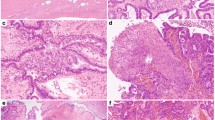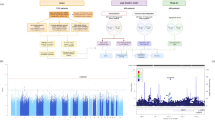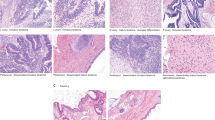Abstract
Loss of heterozygosity (LOH) involving the distal part of the short arm of chromosome 1 occurs frequently in ovarian adenocarcinomas but the tumour suppressor gene(s) targeted by this event is unknown. We have used five microsatellite markers in a panel of 56 ovarian adenocarcinomas to determine which part of 1p34 – 36 is the focus of this LOH. LOH was considerably more common at 1p36 (43%) than at 1p34 – 35 (18%), and 11 tumours showed LOH at 1p36 but not at 1p34 – 35. These data strongly suggest the presence of a tumour suppressor gene inactivated in ovarian adenocarcinoma at 1p36. The p53 homologue, p73, has recently been isolated and mapped to 1p36 and therefore is a candidate for this tumour suppressor gene. However, RT – PCR and Western analyses revealed strong expression of p73 in ovarian adenocarcinoma cell lines but very low or undetectable levels in normal ovarian surface epithelial cells. Immunohistochemical analysis of primary ovarian tumours showed that only 3/22 (14%) contained p73 expressing cells. There was no association between 1p36 LOH and p73 expression in ovarian tumours, nor between p73 and p53 expression. These findings strongly suggest that p73 is not the target of 1p36 LOH in ovarian adenocarcinomas but indicate the presence of an, as yet unidentified, tumour suppressor gene in this region that plays an important role in ovarian tumorigenesis.
This is a preview of subscription content, access via your institution
Access options
Subscribe to this journal
Receive 50 print issues and online access
$259.00 per year
only $5.18 per issue
Buy this article
- Purchase on Springer Link
- Instant access to full article PDF
Prices may be subject to local taxes which are calculated during checkout




Similar content being viewed by others
References
Chenevix-Trench G, Kerr J, Friedlander M, Hurst T, Sanderson B, Coglan M, Ward B, Leary J and Khoo S-K. . 1994 Am. J. Hum. Genet. 55: 1433–1449.
Chenevix-Trench G, Kerr J, Hurst T, Shih Y-C, Purdie D, Bergman L, Friedlander M, Sanderson B, Zournazi A, Coombs T, Leary JA, Crawford E, Shelling AN, Cooke I, Ganesan TS, Searle J, Choi C, Barrett JC, Khoo S-K and Ward B. . 1997 Gene. Chromo. Cancer 18: 75–83.
Dracopoli NC, Harnett P, Bale SJ, Stanger BZ, Tucker MA, Housman DE and Kefford RF. . 1989 Proc. Natl. Acad. Sci. 86: 4614–4618.
Jost CA, Martin MC and Kaelin WG. . 1997 Nature 389: 191–194.
Kaghad M, Bonnet H, Yang A, Creancier L, Biscan J-C, Valent A, Minty A, Chalon P, Lelias J-M, Dumont X, Ferrara P, McKeon F and Caput D. . 1997 Cell 90: 809–819.
Lundgren R, Mandahl N, Heim S, Limon J, Henrikson H and Mitleman F. . 1992 Genes Chromosome Cancer 4: 16–24.
Marin MC, Jost CA, Irwin MS, DeCaprio JA, Caput D and Kaelin WG. . 1998 Mol. Cell. Biol. 18: 6316–6324.
Nagai H, Negrini M, Carter SL, Gillum DR, Rosenberg AL, Schwartz GF and Croce CM. . 1995 Cancer Res. 55: 1752–1757.
Parkin DM, Pisani P and Ferlay J. . 1993 Int. J. Cancer 54: 594–606.
Shelling AN, Cooke IE and Ganesan T. . 1995 Br. J. Cancer 72: 521–527.
Teneriello MG, Ebina M, Linnoila RI, Henry M, Nash JD, Park RC and Birrer MJ. . 1993 Cancer Res. 53: 3103–3108.
Thompson FH, Taetle R, Trent JM, Liu Y, Massey-Brown K, Scott KM, Weinstein RS, Emerson JC, Alberts DS and Nelson MA. . 1997 Cancer Genet. Cytogenet. 96: 106–110.
Tsao S-W, Mok SC, Fey EG, Fletcher JA, Wan TSK, Chew E-C, Muto MG, Knapp RC and Berkowitz RS. . 1995 Exp. Cell. Res. 218: 499–507.
Webb PM, Green A, Cummings M, Purdie D, Walsh M and Chenevix-Trench G. . J. Natl. Cancer Inst. (in press).
White PS, Maris JM, Beltinger C, Sulman E, Marshall HN, Fujimori M, Kaufman BA, Biegel JA, Allen C, Hillard C, Valentine MB, Look AT, Enomoto H, Sakiyama S and Brodeur GM. . 1995 Proc. Natl. Acad. Sci. USA 92: 5520–5524.
Acknowledgements
This work was supported by the Australia/Russia Agreement in Medical Science, the National Health and Medical Research Council of Australia and Queensland Cancer Fund. We would like to thank S-K Khoo, B Ward and T Hurst for surgical specimens.
Author information
Authors and Affiliations
Rights and permissions
About this article
Cite this article
Imyanitov, E., Birrell, G., Filippovich, I. et al. Frequent loss of heterozygosity at 1p36 in ovarian adenocarcinomas but the gene encoding p73 is unlikely to be the target. Oncogene 18, 4640–4642 (1999). https://doi.org/10.1038/sj.onc.1202863
Received:
Revised:
Accepted:
Published:
Issue Date:
DOI: https://doi.org/10.1038/sj.onc.1202863
Keywords
This article is cited by
-
Reduced expression of ELAVL4 in male meningioma patients
Brain Tumor Pathology (2013)
-
p73: Friend or foe in tumorigenesis
Nature Reviews Cancer (2002)
-
Increased susceptibility to tumorigenesis of ski-deficient heterozygous mice
Oncogene (2001)
-
Frequent Loss of Heterozygosity at 1p36.3 and p73 Abnormality in Parathyroid Adenomas
Modern Pathology (2001)



